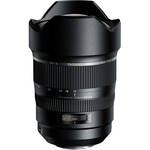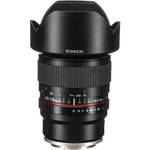Owning the right combination of lenses is perhaps even more important for night photography than owning the right camera. You need lenses with wide apertures that can let in a lot of light. I recommend lenses that have apertures at least as wide as f2.8, as this will help minimize noise.
Ultra-Wide Angle Lenses

|

|

|

|
Sigma 14mm f/1.8 Art This is the first-ever ultra-wide angle f1.8 lens, making it very well suited for night photography. It lets in 2.4 times as much light as a comparable f2.8 lens. It is also a very-high quality Sigma ART lens. |
Tamron 15-30mm f2.8 The quality of the Tamron 15-30 is right up there with the Sigma ART lenses. The widest focal length of this lens is 15mm, versus 14mm for the other full-frame lenses I’ve listed. This is a pretty small difference, but it can be important for night photos, where you often want to include as much of the sky as possible. An advantage of the Tamron is that it can zoom in to 30mm, which can be used for creating larged stitched images. |
Rokinon 14mm f/2.8
If you're on a budget and want just one lens for night photography, I recommend this manual-focus Rokinon lens (sometimes also called Smayang or Bower). It costs around $350 and produces good quality images at night. The wide angle allows you to capture a lot of the sky and provides a lot of depth of field. There are Rokinons available for most camera bodies. There can be issues with quality-control with the Rokinon, so I recommend testing your lens right away and sending it back for replacement if it produces images of noticably low quality. |
Sigma 14-24mm f/2.8 Art The Nikkor 14-24 was my primary lens for night photography for many years, but I now recommend the Sigma 14-24 over the Nikkor. Both lenses perform exceptionally well at night. They are so close that I only recommend the Sigma because it costs about 35% less. It’s also available for many different camera bodies, whereas the Nikkor can only be used on a Nikon unless you buy an adapter. |
20-55mm Lenses
Lenses from 20-50mm are well-suited for making large stitched images of the night sky. Longer lenses will produce bigger, higher-quality stitched images than shorter lenses, but they will also require you to take more photos and spend more time processing the images. 35mm is suitable for many stitched images at night, though I often still use 50mm to make really big stitched images.

|

|

|

|
|
Sigma ART
Sigma ART lenses are some of the highest-quality lenses you can find for night photogrpahy. They can be a bit pricey, but you won't find better quality at a lower price. Sigma has 20mm, 24mm, 30mm, 35mm, and 50mm f.14 ART lenses available for Nikon, Canon and Sony cameras. |
Rokinon These lenses are also marketed under the name Samyang, but they are all the same lens. These are mostly manual-focus lenses that are well-suited for night photography and usually cost about half as much as the Sigma lenses. There are 24mm, 35mm, and 50mm f1.4 Rokinon lenses avaialble for many camera brands, including Nikon, Canon, and Sony. Don't get the Cine version of these lenses, as these are for video. There can be issues with quality-control with the Rokinon, so I recommend testing your lens right away and sending it back for replacement if it produces images of noticably low quality. There are 24mm, 35mm, and 50mm f1.4 Rokinon lenses available. |
Nikon Nikkor 50mm f/1.8D
The Nikkor 50mm produces good quality images and costs barely over $100! It can produce some noticeable coma in the corners of images taken at night. But for stitched images, you can get around this by cropping off the sides of the image before stitching it (there's more info on this in my Night Photography Guide). |
Canon 50mm f/1.8 STM
Like the Nikkor 50mm, this lens costs a little over $100 and produces good quality images. It can also produce some noticealbe coma in the corners, but again you can get around this by cropping the edges of images before stitching them. |
Telephoto Lenses
 |
|
Sigma 150-600mm f/5.0-6.3 A telephoto lens is not very practical for most nightscapes that include a foreground and the night sky in the image. However, it can be useful for photographing just the sky and capturing lunar eclipses or perhaps a comet. It can also be useful for capturing natural light sources here on Earth that you can't get too close to, like lava or forest fires. |
Fisheye Lenses
 |

|
|
Rokinon 8mm f/3.5 Fisheye Fisheye lenses produce a lot of distortion, but can also capture an extremely wide field of view. This circular fisheye captures a 180 degree field of view across the entire image and renders the image as a circle with a black border around it. If you point this lens straight up, you can capture the entire night sky and the horizon will be rendered as a circle around the edge of the image. |
Rokinon 12mm f/2.8 Fisheye This is a diagonal fisheye, which captures a 180 degree field of view from corner to corner but not across the entire image. It renders the image as a standard rectangular image rather than a circular image. It's reasonably priced at around $300. |
Lenses for APS-C (cropped) Sensors

|

|
Tokina 11-20mm f2.8 DX If you have a camera with a cropped sensor, I still recommend all of the lenses listed above, as they'll also work on APS-C cameras. If you ever upgrade to a full-frame camera, you'll still be able to use the same lenses instead of buying new ones. However, the full-frame lenses don't provide as wide of a field of view when used on a APS-C camera. Therefore, for your widest lens, you may want to get the Tokina 11-20mm, as it can produce very good quality images at night. |
Rokinon 10mm f2.8 Like most Rokinons, this is a manual-focus lens that can produce good results at night. It doesn't have the zoom capabilities of the Tokina 11-20, but it is a little wider, which can sometimes make a big difference at night. |
[ Cameras | Lenses | Tripods | Accessories | Lighting | Clothing | Survival | Websites | Software | iTunes | Android ]
Back to Night Photography Resources Home Page
Back to Collier Photography Home Page